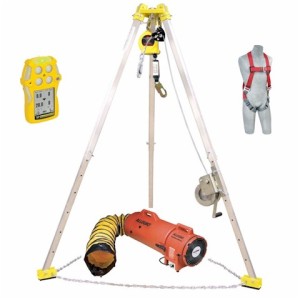What are confined space kits? Which one is right for my job application? This brief post will answer these questions and provide a basic knowledge of confined space kits. The hope is to provide you the necessary information to make informed decisions in your purchasing efforts.
Confined Space Kits – What Are They?
Generally, confined space kits consist of a complete tripod rescue system, a gas monitor or gas detector, a ventilation blower, and a fall protection harness. In your average confined space entry application, all of these items are needed or should be readily available.
In this confined space kit, for example, all of the above are included: (1) confined space gas detector; (2) ventilation blower with the attached 15′ of duct; (3) fall protection rescue harness; (4) rescue tripod, rescue winch, self retracting lifeline, pulley and carabiners.
Each one of these pieces of equipment is needed to safely enter, work in, and exit a confined space.
The gas detector is necessary to check the space before entry and then to continuously monitor the space upon entry.
The ventilation blower is needed to recirculate the air for a healthier work environment. Importantly, it is also needed to refresh the air if the gas detector determines the presence of toxic conditions.
The rescue tripod, winch, retractable lifeline, and harness allow for safe entry, fall protection, and rescue (if needed).
Differences Between Confined Space Kits
The main differences between the various confined space kits are found in the variety of components that are available.
The gas detector, for example, might be a diffusion type, or have an internal pump that connects to sample tubing. The detectors might also differ in power source – some using alkaline batteries and some using rechargeable batteries.
The ventilation blowers are usually 8″ blowers with either 15′ or 25′ of duct. The most common power source offered is electric. However, gas and pneumatic powered blowers are often available. It’s important to make sure that a duct carrier is included – like the blower system pictured above.
Differences in the rescue tripods are generally found in the type/number of winches offered. The most common configuration is a basic rescue winch with a self retracting lifeline mounted to the top of the tripod (as pictured above). Some kits may offer a 3-way winch in place of the basic winch. Some kits may offer a 3-way winch, a basic winch, and a self retracting lifeline.
Which Confined Space Kit Is Right For Me?
It’s important to remember that the differences between the kits are not in their safety approvals. Any decent kit will meet the OSHA stipulated ANSI standards. Generally, deciding which kit is best for you comes down to personal preference and budget.
A 3-way winch, for example, is more convenient than a normal winch, but is quite a bit more money. A gas detector with an internal sample pump is more convenient for remote sampling, but it is also more money. A diffusion detector can also test remotely. All one needs to do is tie a rope to it and lower it down into the space. Blowers with 25′ duct seem more appealing, but rarely is 25′ of duct needed.
If you have any questions, or need help deciding, don’t hesitate to ask us. We are glad to help. Note – you can find a variety of confined space kits at majorsafety.com. Click Here to view the various kits available.


